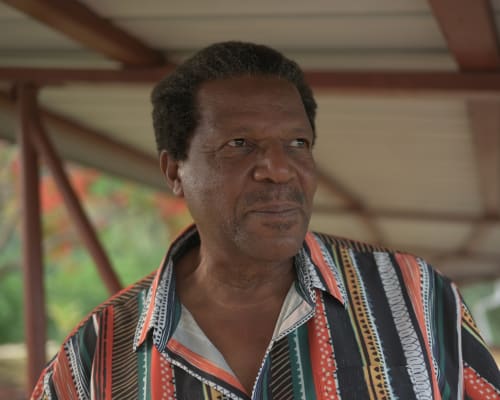"I share the concern of many artists – to transmute paint a base material, into the gold of an universal consciousness – and to relieve painting of parochialism and other cultural deadwood that limit artistic power and significance."
Kenwyn Crichlow is a painter, arts leader, and educator with a studio practice in Curepe, Trinidad. Crichlow's paintings were recently included in Infinite Regress: Mystical Abstraction from the Permanent Collection, curated by Kevin Moore, at The Kemper Museum of Art (2024) in Kansas City and Keeping Time, curated by Ekow Eshun and Karon Hepburn, at Gallery 1957, in Accra, Ghana (2024). In 2023, he received a solo survey, Incandescence, with Diane Rosenstein Gallery Los Angeles in 2023, accompanied by a retrospective catalogue.
Crichlow’s paintings are in the permanent collection of the Barbados National Art Gallery, Barbados; Mervyn Awon Collection, Barbados; and the Central Bank Museum, National Art Museum, and Republic Bank Art Collection, all in Trinidad. The artist received a MPhil from the University of the West Indies, Kingston, Jamaica (2019); BA from Goldsmiths College, University of London, UK (1978), and a Teacher's Certificate from Mausica Teachers College, Trinidad and Tobago (1972).
His paintings were exhibited in solo and group presentations with Diane Rosenstein Gallery, Los Angeles, at Independent 20th Century, New York City, NY (2023), and in solo shows at Y Gallery, Port of Spain, TT (2013-2022). Other group exhibitions include First Caribbean Biennial, Museum of Modern Art, Santo Domingo, Dominican Republic (1992); Caribbean Art Now, Commonwealth Institute, London, UK (1986); Caribbean Artists Today, Drexel University, Philadelphia, PA (1990), Caribbean Visions: Contemporary Painting and Sculpture, curated by Samella Lewis, Center for the Fine Arts, Miami, FL (1995-97), Season of Renewal, 50th Anniversary Exhibition, The Museum of the West Indies, Kingston, Jamaica (2012), among others.
In 2024, he received the Hummingbird Medal Gold, a National Award presented by the President of Trinidad and Tobago for his service in the arts. He is the Board Chair of the National Museum and Art Gallery, TT (2019-2025) and the founding coordinator of the Visual Arts Program in the Department of Creative and Festival Arts at the University of the West Indies, St. Augustine, TT (1968 - 2016). Crichlow's writing, lectures, and contributions as juror both of fine art and carnival have had significant impact on the arts in the Caribbean.

